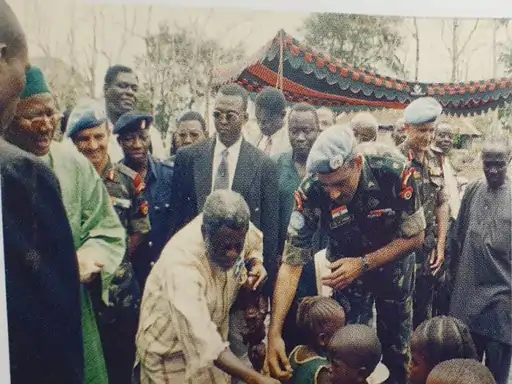Source : DNA INDIA NEWS
A multinational operation involving India, Ghana, Britain and Nigeria was launched on June 13, 2000, to break the two-month-long siege laid by armed cadres of the Revolutionary United Front (RUF).
Operation Khukri of Indian Army in Sierra Leone (File Image)
Operation Khukri is in the news once again, after a gap of 25 years, when 233 soldiers of the Indian Army were taken hostage by rebel forces in the West African country of Sierra Leone. Randeep Hooda will portray Major General Raj Pal Punia in the upcoming military drama movie of the same name. Poonia was the Company Commander of the 14th mechanised infantry, he navigated the stand-off. The movie is based on Penguin Random House India’s bestseller ‘Operation Khukri: The Untold Story of the Indian Army’s Bravest Peacekeeping Mission Abroad’.
What happened to Indian Army in Sierra Leone?
A multinational operation involving India, Ghana, Britain and Nigeria was launched on June 13, 2000, to break the two-month-long siege laid by armed cadres of the Revolutionary United Front (RUF). India sent the 5/8th Gorkha Rifles, 14th Mechanised Infantry and the 23rd Mechanised Infantry to Sierra Leone to help the government disarm the RUF rebels. The Indian contingent was collectively called INDBATT-1. At a meeting with the RUF rebels, some of the commanders at Kailahun were captured. Some of the hostages were released within ten days.
RUF rebels capture 500 Kenyan peacekeepers
The rebels took 500 Kenyan peacekeepers and started marching towards the capital city of Freetown, where Indian soldiers were deployed. The Indian contingent advanced, took on the RUF rebels and liberated the Kenyan troops. The situation at Kailahun deteriorated, and the two companies of 5/8th Gorkha Rifles remained there, surrounded by hundreds of rebels. Talks to free the Indian soldiers continued for 75 days without any result. In the meantime, preparations were made to break the siege of Kailahun.
Operation Khukri succeeds
The Indian contingent at Kailahun was informed of the plan, and they were kept in constant touch through satellite phones and Malayalam was chosen to communicate so that the rebels could not understand it. The Indian operation succeeded, and they broke the siege at Kailahun and freed all soldiers. One soldier was killed in Operation Khukri, which was a big boost to UNAMSIL morale. The Indian Army was welcomed with a rapturous welcome as they marched triumphantly into Daru.
SOURCE : DNA NEW







